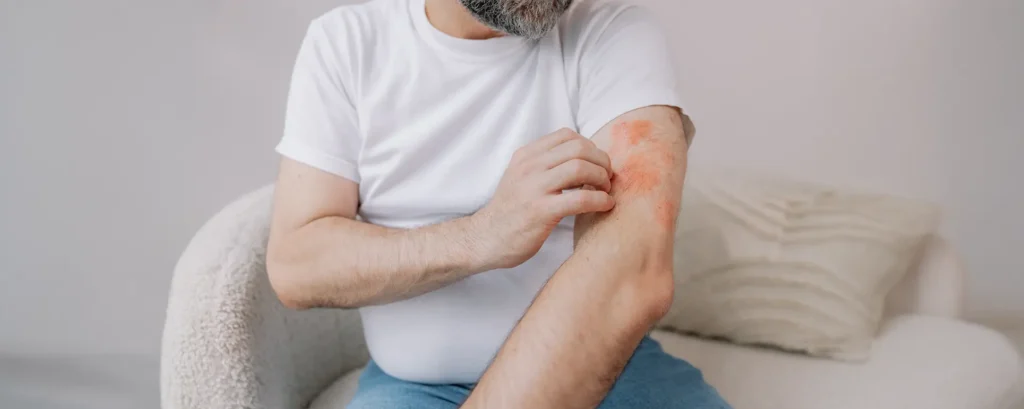It can be unsettling when you wake up in the morning or go about your day, only to suddenly notice red, itchy welts appearing across your skin. These raised marks, commonly called hives and known medically as urticaria, often show up without any warning. One moment your skin looks perfectly clear, and the next, you’re dealing with patches that burn, sting, or itch intensely. Sometimes they fade within a few hours, other times they linger for days, and for many people, they seem to vanish just as mysteriously as they appeared.
If this has ever happened to you, you’re not alone. Hives are surprisingly common, affecting millions of people worldwide each year. They can occur in both children and adults, in people with allergies and in those who’ve never had a noticeable reaction to anything before. That unpredictability is what makes them so frustrating. You may rack your brain trying to figure out what you ate, touched, or did differently, only to find no obvious explanation. It can leave you feeling anxious and wondering, Why me?
The reality is that hives are usually not dangerous. In fact, most cases are temporary and harmless, resolving on their own without treatment. But just because they’re not typically a medical emergency doesn’t mean they should be ignored. Hives are your body’s way of signalling that your immune system is reacting to something it perceives as a threat. That “something” might be an allergen, such as a food or medication, but it can also be a wide range of triggers you might not expect heat, stress, exercise, infections, or even pressure on the skin from tight clothing.
So what’s really happening beneath the surface? Hives form when specialised immune cells release histamine and other chemicals into your bloodstream. Histamine makes tiny blood vessels leak fluid into the skin, creating those swollen, itchy welts. It’s essentially your body’s defence mechanism at work, although in the case of hives, it can feel more like an overreaction than a protective measure.
As someone who has spent years helping patients understand unexplained skin conditions, I can tell you this: while hives often seem random, they rarely are. There is almost always a reason even if it’s not obvious at first glance. For some people, the trigger is easy to spot, like eating shellfish or taking a certain medicine. For others, it may take weeks of observation, testing, and patience to uncover the hidden cause. And in some cases, especially when hives last for longer than six weeks, they fall into a category known as chronic urticaria, where pinpointing the exact trigger can be much more challenging.
In this article, we’ll take a closer look at the common reasons why hives appear so suddenly, the wide range of triggers that may be setting them off, and practical steps you can take to manage them. I’ll also share insights into when hives are nothing to worry about and when they might be a sign that you should seek medical advice right away. By the end, you’ll have a clearer understanding of what’s happening when those red welts unexpectedly cover your skin and more importantly, how you can take back control when it happens.
What Are Hives?

Hives, also known by their medical name urticaria, are raised, itchy welts that can develop on any part of the body. They often appear suddenly and may look red or pink on lighter skin tones, or slightly darker or skin-coloured on deeper skin tones. The welts themselves can vary a great deal in appearance: some are tiny pinhead-sized spots, while others merge together to form larger patches that cover wider areas of the skin. One of the most distinctive features of hives is that they are not fixed in one place. They can change shape, move around, or disappear from one spot only to reappear somewhere else within a matter of hours.
The underlying cause of these welts is a release of histamine and other chemicals from specialised immune cells in the skin. Histamine increases the permeability of blood vessels, allowing fluid to leak into the surrounding tissue. This is what produces the swelling, redness, and itching that people associate with hives. While histamine is meant to help the body defend itself from perceived threats, in the case of hives, the reaction can often seem exaggerated or unnecessary.
For many people, hives are short-lived. They may come on suddenly and then fade within a few hours, sometimes lasting no longer than a single day. However, in other cases, they can recur repeatedly over days or weeks, creating a cycle that feels both frustrating and disruptive. Chronic hives, which last for six weeks or more, can have a particularly significant impact on daily life. The constant itching, combined with the unpredictable flare-ups, can interfere with sleep, concentration, and even self-confidence in social situations.
Although hives themselves are rarely dangerous, the experience can be distressing. Understanding what they are and why they happen is the first important step in managing them effectively. By learning about potential triggers and recognising patterns in when and how hives appear, many people find they can take control of their symptoms and reduce the frequency of outbreaks.
Common Causes of Sudden Hives

When hives appear without warning, it can feel mysterious and unsettling. While the exact reason can vary from person to person, doctors generally group the causes into several categories. Some are linked to allergies, others to environmental or physical triggers, and in some cases, hives occur without any clear explanation at all. Let’s look at the most common culprits in more detail.
1. Allergic Reactions
Perhaps the most widely recognised cause of hives is an allergic reaction. This happens when your immune system mistakenly identifies a harmless substance as dangerous and overreacts by releasing histamine. The result? Those red, itchy welts that can spread quickly.
- Foods: Certain foods are well-known triggers. Nuts, shellfish, eggs, and dairy are common offenders, but wheat, soy, strawberries, and food additives such as preservatives or artificial colourings can also set off outbreaks. Food-related hives often appear within minutes to a couple of hours after eating, though in some cases, the delay can make it harder to link the reaction to a specific food.
- Medications: Drugs like antibiotics (especially penicillin and sulfa drugs), aspirin, ibuprofen, and other NSAIDs are known to cause hives in sensitive individuals. Even prescription medications taken for years without a problem can suddenly lead to reactions.
- Insect stings or bites: Bee and wasp stings, mosquito bites, and fire ant stings can all provoke sudden hive flare-ups. In more severe cases, these reactions may be part of an allergic emergency known as anaphylaxis.
While many hives caused by allergies disappear once the allergen is avoided, the unpredictable nature of the immune system means that sometimes welts appear even when you can’t pinpoint any obvious allergen.
2. Physical Triggers
Not all hives are linked to what you eat or the medications you take. For some people, their skin itself is unusually reactive to physical stimuli. This form of hives is called physical urticaria, and it happens when everyday conditions provoke welts.
- Pressure hives: Carrying a heavy bag on your shoulder, wearing tight waistbands, or sitting for long periods can create hives in areas where the skin is pressed.
- Temperature extremes: Cold-induced hives may appear after stepping outside in freezing air or jumping into cold water, while heat-induced hives can be triggered by hot showers, saunas, or warm weather.
- Sunlight: In rare cases, people develop hives after direct exposure to sunlight a condition called solar urticaria. Even short exposure can cause a reaction.
- Exercise and sweating: When the body heats up during exercise, some people experience cholinergic urticaria, where tiny itchy bumps appear on the chest, arms, or face. Sweating itself can act as a trigger.
These physical hives usually disappear once the trigger is removed, but because triggers are part of everyday life clothing, weather, or exercise they can be particularly disruptive.
3. Infections
Another overlooked cause of hives is infection. Viral infections are one of the most common triggers, particularly in children, though adults can be affected as well. When the immune system fights off an infection, the release of immune chemicals like histamine can trigger skin reactions.
- Viral infections: Common culprits include colds, flu, glandular fever, and even hepatitis. For children, simple viral infections are often the explanation behind sudden outbreaks of hives.
- Bacterial infections: Strep throat and urinary tract infections have been linked to hives in some cases.
- Other infections: Occasionally, parasitic or fungal infections can play a role, though these are less common.
The hives generally disappear once the infection clears, but while they last, they can add an extra layer of discomfort to being unwell.
4. Stress
Many people are surprised to learn that stress can directly affect their skin. Emotional stress doesn’t just affect your mind it also influences your immune system and hormone levels. In people who are sensitive, stress and anxiety can cause mast cells (immune cells in the skin) to release histamine, which then produces hives.
This doesn’t mean that every stressful moment will result in welts, but if you notice that hives flare up during exams, job interviews, or periods of emotional strain, stress may well be a contributing factor. Unlike food or medication triggers, stress is harder to avoid, making stress-related hives particularly challenging.
5. Chronic Spontaneous Urticaria (CSU)
In some cases, hives don’t seem to have any identifiable trigger. This condition is called chronic spontaneous urticaria (CSU). By definition, CSU is when hives last or recur for six weeks or longer without an obvious cause.
Researchers believe CSU often involves an autoimmune process, where the immune system mistakenly targets the body’s own tissues. Unlike allergic hives, which typically fade when the allergen is removed, CSU can persist for months or even years, coming and going without warning. It affects quality of life significantly, as flare-ups may interfere with sleep, work, and daily comfort.
CSU usually requires specialist care from a dermatologist or allergist, as over-the-counter remedies often aren’t enough. While the exact cause is still being studied, ongoing research is shedding light on immune system mechanisms that may drive this condition.
When Should You See a Dermatologist?
For most people, hives are temporary and harmless. They appear suddenly, itch intensely, and then fade within hours or a day, leaving little lasting impact. However, there are times when hives signal that a professional evaluation is necessary. Consulting a dermatologist can help you understand the underlying cause, manage flare-ups more effectively, and prevent future episodes from interfering with your daily life.
You should seek medical advice if you experience any of the following:
- Recurring or persistent hives: If your hives last for more than six weeks or keep coming back without an obvious cause, this may indicate chronic urticaria. Persistent hives can interfere with sleep, work, and overall quality of life, so it’s important to get proper guidance from a specialist.
- Swelling of lips, tongue, or throat: This can be a sign of angioedema, which may accompany severe allergic reactions. Swelling in these areas can be life-threatening if it affects breathing and requires immediate medical attention.
- Hives with systemic symptoms: Dizziness, shortness of breath, rapid heartbeat, or fainting alongside hives may indicate a serious allergic reaction, such as anaphylaxis, which is a medical emergency.
Even if your hives aren’t severe, seeing a dermatologist in London can still be beneficial. They can help identify triggers, provide personalised treatment plans, and suggest strategies to reduce or prevent future outbreaks. Diagnostic tools may include blood tests to check for underlying conditions, allergy testing to identify potential allergens, or imaging in rare cases where a more complex cause is suspected.
Treatment options your dermatologist might recommend include:
- Antihistamines: These are usually the first line of treatment and can help reduce itching and prevent new welts from forming.
- Topical or oral medications: For more stubborn cases, corticosteroids or other immune-modulating medications may be prescribed.
- Lifestyle and trigger management: Your dermatologist can guide you on identifying patterns, avoiding known triggers, and adopting habits that reduce flare-ups, such as stress management, dietary adjustments, or avoiding extreme temperatures.
By seeking professional advice, you gain both clarity and peace of mind. Understanding the “why” behind your hives and having a clear plan for managing them can make a significant difference, helping you live comfortably without the constant worry of sudden skin reactions.
Managing Hives at Home
Even before your dermatologist appointment, there are several strategies you can use to manage hives and reduce discomfort. While these measures may not address the underlying cause, they can provide significant relief and help you cope with flare-ups as they occur.
- Antihistamines: Over-the-counter antihistamines, such as cetirizine, loratadine, or fexofenadine, are often the first line of defence against hives. They work by blocking histamine, the chemical responsible for swelling and itching. Taking them as directed can help reduce discomfort, prevent new welts from forming, and make sleep more comfortable during flare-ups. Always check with your pharmacist or doctor if you’re taking other medications to avoid potential interactions.
- Cool compresses: Applying a cold, damp cloth or an ice pack wrapped in a soft towel to affected areas can soothe itching and reduce redness. Short, repeated applications 10 to 15 minutes at a time are usually most effective. Avoid direct ice on the skin, as this can cause irritation or frostbite.
- Avoid triggers: Keeping a detailed diary of foods, medications, environmental exposures, and activities can help you and your dermatologist identify potential triggers. Note when hives appear, how long they last, and any associated symptoms. Over time, patterns may emerge that make it easier to avoid future outbreaks.
- Loose, breathable clothing: Tight or rough fabrics can aggravate itching and pressure-induced hives. Opt for soft, loose-fitting clothing made of natural fibres like cotton, which allow the skin to breathe and reduce friction.
- Stress management: Stress and anxiety can exacerbate hives in sensitive individuals. Techniques such as meditation, deep breathing exercises, yoga, or gentle forms of exercise can help reduce stress-related flare-ups. Even short daily sessions of mindfulness can make a noticeable difference over time.
- Other supportive measures: Taking lukewarm showers rather than hot ones, avoiding harsh soaps or fragrances, and keeping nails trimmed to prevent skin damage from scratching can also help minimise irritation during a flare-up.
While these at-home strategies can ease symptoms, they are not a substitute for professional evaluation. Identifying the root cause whether it’s an allergen, physical trigger, infection, or autoimmune response is essential for long-term management. Combining self-care with guidance from a dermatologist ensures that you not only manage symptoms but also reduce the likelihood of future outbreaks.
Final Thought: Understanding and Managing Sudden Hives
Hives may appear suddenly, but they often have an underlying cause that can be identified with the right approach. Whether triggered by food, medication, stress, or a chronic autoimmune response, understanding your body’s reactions is essential.
You can schedule a consultation with a dermatologist in London to receive personalised advice, identify triggers, and explore treatment strategies that reduce flare-ups and improve your quality of life.
References:
- Kolkhir, P., Giménez-Arnau, A.M. & Maurer, M., 2022. Urticaria. Nature Reviews Disease Primers, 8(1), pp.1–18. Available at: https://www.nature.com/articles/s41572-022-00389-z
- Dabija, D., 2023. Chronic Urticaria. In: StatPearls. Treasure Island (FL): StatPearls Publishing. Available at: https://www.ncbi.nlm.nih.gov/books/NBK555910/
- Kolkhir, P., Giménez-Arnau, A.M. & Maurer, M., 2022. Urticaria. Nature Reviews Disease Primers, 8(1), pp.1–18. Available at: https://www.nature.com/articles/s41572-022-00395-1
- Sánchez-Borges, M., 2012. Diagnosis and Treatment of Urticaria and Angioedema. World Allergy Organization Journal, 5(3), pp.125–130. Available at: https://pmc.ncbi.nlm.nih.gov/articles/PMC3651155/
- Konstantinou, G.N., 2020. Psychological Stress and Chronic Urticaria: A Neuroimmune Perspective. Journal of Investigative Dermatology, 140(3), pp.593–595. Available at: https://pubmed.ncbi.nlm.nih.gov/32360096/
